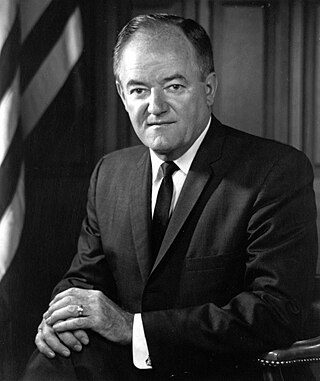
Hubert Horatio Humphrey Jr. was an American politician and statesman who served as the 38th vice president of the United States from 1965 to 1969. He twice served in the United States Senate, representing Minnesota from 1949 to 1964 and again from 1971 to 1978. As a senator he was a major leader of modern liberalism in the United States. As President Lyndon B. Johnson's vice president, he supported the controversial Vietnam War. An intensely divided Democratic Party nominated him in the 1968 presidential election, which he lost to Republican nominee Richard Nixon.

Lyndon Baines Johnson, also known as LBJ, was the 36th president of the United States, serving from 1963 to 1969. He became president after the assassination of John F. Kennedy, under whom he had served as the 37th vice president from 1961 to 1963. A Democrat from Texas, Johnson previously served as a U.S. representative and U.S. senator.
The presidency of Ronald Reagan began on January 20, 1981, when Ronald Reagan was inaugurated as the 40th president of the United States, and ended on January 20, 1989.
The presidency of Richard Nixon began on January 20, 1969, when Richard Nixon was inaugurated as the 37th president of the United States, and ended on August 9, 1974, when, in the face of almost certain impeachment and removal from office, he resigned the presidency.
The presidency of Lyndon B. Johnson began on November 22, 1963, when Lyndon B. Johnson became the 36th president of the United States following the assassination of President John F. Kennedy. His term ended on January 20, 1969.
The presidency of Dwight D. Eisenhower began on January 20, 1953, when Dwight D. Eisenhower was inaugurated as the 34th president of the United States, and ended on January 20, 1961.
The presidency of Harry S. Truman began on April 12, 1945, when Harry S. Truman became the 33rd president upon the death of Franklin D. Roosevelt, and ended on January 20, 1953.
The following is a timeline of the presidency of Jimmy Carter, from January 1, 1980, to January 20, 1981.
The following is a timeline of the presidency of Bill Clinton, from January 1, 1995 to December 31, 1995.
The following is a timeline of the presidency of Lyndon B. Johnson from January 1, 1967, to December 31, 1967.
The following is a timeline of the presidency of Bill Clinton from his inauguration as the 42nd president of the United States on January 20, 1993, to December 31, 1993.
The following is a timeline of the presidency of Bill Clinton, from January 1, 1994 to December 31, 1994.
The following is a timeline of the presidency of Bill Clinton from January 1, 1997, to December 31, 1997.
The following is a timeline of the presidency of George H. W. Bush, from January 1, 1990 to December 31, 1990.
The following is a timeline of the presidency of George H. W. Bush from his inauguration as the 41st president of the United States on January 20, 1989, to December 31, 1989.
The following is a timeline of the presidency of Richard Nixon from his inauguration as the 37th president of the United States on January 20, 1969, to December 31, 1969.

The following is a timeline of the presidency of Richard Nixon from January 1, 1970, to December 31, 1970.
The following is a timeline of the presidency of Ronald Reagan from January 1, 1987, to December 31, 1987.
The following is a timeline of the presidency of Lyndon B. Johnson from January 1, 1964, to December 31, 1964.
The following is a timeline of the presidency of Richard Nixon from January 1, 1974, to August 9, 1974, when, in the face of almost certain impeachment and removal from office, he resigned the presidency.






